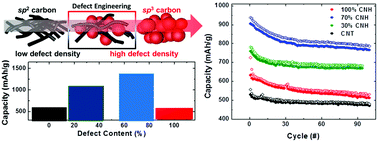Nanoscale defect engineering of lithium–sulfur battery composite cathodes for improved performance†
Abstract
For lithium–sulfur batteries to surpass the energy density of lithium-ion batteries, sulfur-containing cathodes require high sulfur loading (>70 wt%) relative to all inactive components, anchoring sites to prevent polysulfide shuttling, high capacity (>1000 mA h g−1), and stable cycling performance. Here we demonstrate a nanomanufacturing route to produce low-density hybrid nanomaterial electrodes that synergize the mechanical and electrical integrity of carbon nanotubes (CNTs) with the chemical defect properties of carbon nanohorns (CNHs) to produce carefully optimized properties for binder-free lithium–sulfur battery cathodes. High sulfur loadings (>75%) are achieved through a brief (<20 minute) vapor phase treatment at 155 °C, with sulfur infiltration kinetics that increase with defect content of the hybrid composite. By controlling the relative concentration of CNHs to CNTs, and hence defect engineering the composite, we determine an optimized hybrid structure with a 7 : 3 relative weight ratio that exhibits a reversible capacity of more than 1200 mA h gsulfur−1 when operated at 0.1C and a capacity retention of over 85% after 100 cycles. The excellent cyclability and high capacity of these electrodes is one of the best reported to date for binder-free carbon composites and we demonstrate this to be due to the role of defects in promoting the retention of high order polysulfides for subsequent conversion to the insoluble low-order polysulfide reaction product. Our work highlights the critical intersection between controllably manufactured compositions of hybrid nanostructures and improved performance in batteries capable of surpassing the energy storage capability of conventional Li-ion.


 Please wait while we load your content...
Please wait while we load your content...